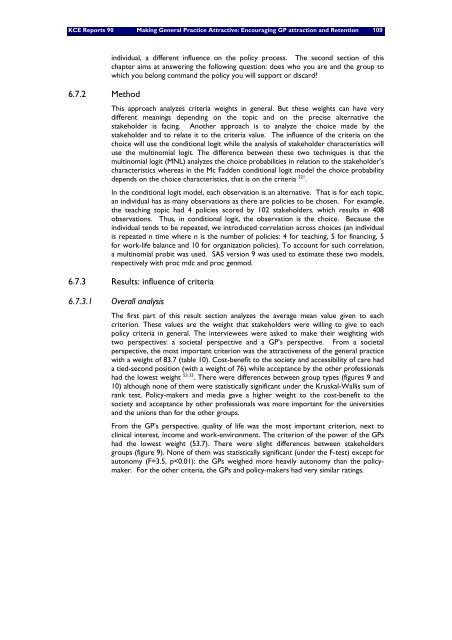Download the report (150 p.) - KCE
Download the report (150 p.) - KCE
Download the report (150 p.) - KCE
You also want an ePaper? Increase the reach of your titles
YUMPU automatically turns print PDFs into web optimized ePapers that Google loves.
<strong>KCE</strong> Reports 90 Making General Practice Attractive: Encouraging GP attraction and Retention 109<br />
6.7.2 Method<br />
individual, a different influence on <strong>the</strong> policy process. The second section of this<br />
chapter aims at answering <strong>the</strong> following question: does who you are and <strong>the</strong> group to<br />
which you belong command <strong>the</strong> policy you will support or discard?<br />
This approach analyzes criteria weights in general. But <strong>the</strong>se weights can have very<br />
different meanings depending on <strong>the</strong> topic and on <strong>the</strong> precise alternative <strong>the</strong><br />
stakeholder is facing. Ano<strong>the</strong>r approach is to analyze <strong>the</strong> choice made by <strong>the</strong><br />
stakeholder and to relate it to <strong>the</strong> criteria value. The influence of <strong>the</strong> criteria on <strong>the</strong><br />
choice will use <strong>the</strong> conditional logit while <strong>the</strong> analysis of stakeholder characteristics will<br />
use <strong>the</strong> multinomial logit. The difference between <strong>the</strong>se two techniques is that <strong>the</strong><br />
multinomial logit (MNL) analyzes <strong>the</strong> choice probabilities in relation to <strong>the</strong> stakeholder’s<br />
characteristics whereas in <strong>the</strong> Mc Fadden conditional logit model <strong>the</strong> choice probability<br />
depends on <strong>the</strong> choice characteristics, that is on <strong>the</strong> criteria 221 .<br />
In <strong>the</strong> conditional logit model, each observation is an alternative. That is for each topic,<br />
an individual has as many observations as <strong>the</strong>re are policies to be chosen. For example,<br />
<strong>the</strong> teaching topic had 4 policies scored by 102 stakeholders, which results in 408<br />
observations. Thus, in conditional logit, <strong>the</strong> observation is <strong>the</strong> choice. Because <strong>the</strong><br />
individual tends to be repeated, we introduced correlation across choices (an individual<br />
is repeated n time where n is <strong>the</strong> number of policies: 4 for teaching, 5 for financing, 5<br />
for work-life balance and 10 for organization policies). To account for such correlation,<br />
a multinomial probit was used. SAS version 9 was used to estimate <strong>the</strong>se two models,<br />
respectively with proc mdc and proc genmod.<br />
6.7.3 Results: influence of criteria<br />
6.7.3.1 Overall analysis<br />
The first part of this result section analyzes <strong>the</strong> average mean value given to each<br />
criterion. These values are <strong>the</strong> weight that stakeholders were willing to give to each<br />
policy criteria in general. The interviewees were asked to make <strong>the</strong>ir weighting with<br />
two perspectives: a societal perspective and a GP’s perspective. From a societal<br />
perspective, <strong>the</strong> most important criterion was <strong>the</strong> attractiveness of <strong>the</strong> general practice<br />
with a weight of 83.7 (table 10). Cost-benefit to <strong>the</strong> society and accessibility of care had<br />
a tied-second position (with a weight of 76) while acceptance by <strong>the</strong> o<strong>the</strong>r professionals<br />
had <strong>the</strong> lowest weight 53 33 . There were differences between group types (figures 9 and<br />
10) although none of <strong>the</strong>m were statistically significant under <strong>the</strong> Kruskal-Wallis sum of<br />
rank test. Policy-makers and media gave a higher weight to <strong>the</strong> cost-benefit to <strong>the</strong><br />
society and acceptance by o<strong>the</strong>r professionals was more important for <strong>the</strong> universities<br />
and <strong>the</strong> unions than for <strong>the</strong> o<strong>the</strong>r groups.<br />
From <strong>the</strong> GP’s perspective, quality of life was <strong>the</strong> most important criterion, next to<br />
clinical interest, income and work-environment. The criterion of <strong>the</strong> power of <strong>the</strong> GPs<br />
had <strong>the</strong> lowest weight (53.7). There were slight differences between stakeholders<br />
groups (figure 9). None of <strong>the</strong>m was statistically significant (under <strong>the</strong> F-test) except for<br />
autonomy (F=3.5, p
















